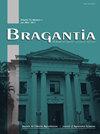Changes in Extreme Air Temperatures in One of South America’s Longest Meteorological Records: Campinas, Brazil (1890-2022)
IF 1.5
4区 农林科学
Q2 Agricultural and Biological Sciences
引用次数: 0
Abstract
The frequency of extreme weather events has increased in almost all regions of the world. In this context, it is vital to understand how the location, scale, and shape of their frequency distributions are changing over time. This study used the flexibility of neural networks to model changes in the probability of daily extremes of maximum (Tmax) and minimum (Tmin) air temperature data in Campinas, Brazil — one of South America’s longest meteorological records spanning from 1890 to 2022. Based on the Extremal Types Theorem, we employed a conditional density network to model the parameters of the generalized extreme value distribution (GEV-CDN) as functions of time. Our findings indicate that a GEV-based model, where the location and scale parameters vary over time, best described the variations in the Tmin series. However, a GEV-based model with only the location parameter varying over time best described the variations in the Tmax series. From an agrometeorological perspective, these results suggest that the probability of Tmax values leading to crop failures is rapidly increasing. The findings indicate a decrease in the probability of agronomic frost events in Campinas over the past 133 years, but the rate of this decrease has slowed in recent years. This result, combined with the negative value of the GEV’s shape parameter, suggests that it is unlikely that Campinas may become an agronomic-frost-free region. To facilitate visualization of the changes in the probability of Tmax and Tmin values from 1890 to 2022, we have developed an internet application available at https://climatology-iac.shinyapps.io/Shinny/.南美洲最长气象记录之一的极端气温变化:巴西坎皮纳斯(1890-2022)
极端天气事件的频率在世界几乎所有地区都有所增加。在这种情况下,了解它们的频率分布的位置、规模和形状如何随时间变化是至关重要的。这项研究利用神经网络的灵活性来模拟巴西坎皮纳斯气温数据的日极端最大值(Tmax)和最小值(Tmin)的概率变化,这是南美洲最长的气象记录之一,从1890年到2022年。基于极值类型定理,利用条件密度网络建立了广义极值分布(GEV-CDN)参数随时间的函数模型。我们的研究结果表明,基于gev的模型,其中位置和尺度参数随时间变化,最好地描述了Tmin系列的变化。然而,只有位置参数随时间变化的基于gev的模型最好地描述了Tmax系列的变化。从农业气象的角度来看,这些结果表明Tmax值导致作物歉收的概率正在迅速增加。研究结果表明,在过去的133年里,坎皮纳斯农业霜冻事件的概率有所下降,但近年来下降的速度有所放缓。这一结果与GEV形状参数的负值相结合,表明坎皮纳斯不太可能成为一个农艺学无霜区。为了方便可视化从1890年到2022年Tmax和Tmin值的概率变化,我们开发了一个互联网应用程序,可在https://climatology-iac.shinyapps.io/Shinny/上获得。
本文章由计算机程序翻译,如有差异,请以英文原文为准。
求助全文
约1分钟内获得全文
求助全文
来源期刊

Bragantia
AGRICULTURE, MULTIDISCIPLINARY-
CiteScore
2.40
自引率
8.30%
发文量
33
审稿时长
4 weeks
期刊介绍:
Bragantia é uma revista de ciências agronômicas editada pelo Instituto Agronômico da Agência Paulista de Tecnologia dos Agronegócios, da Secretaria de Agricultura e Abastecimento do Estado de São Paulo, com o objetivo de publicar trabalhos científicos originais que contribuam para o desenvolvimento das ciências agronômicas.
A revista é publicada desde 1941, tornando-se semestral em 1984, quadrimestral em 2001 e trimestral em 2005.
É filiada à Associação Brasileira de Editores Científicos (ABEC).
 求助内容:
求助内容: 应助结果提醒方式:
应助结果提醒方式:


